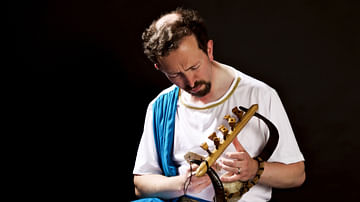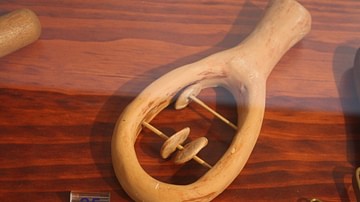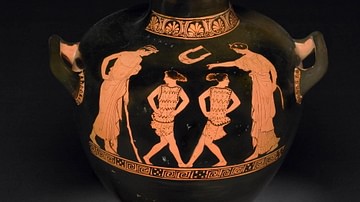
The sistrum (rattle) was a musical percussion instrument first used by the ancient Egyptians, commonly used in ancient Greek musical practices, and often depicted in visual arts such as sculpture and pottery. Made from clay, wood, or metal, the instrument provided rhythmical accompaniment to other instruments, particularly in religious rites and festivals. Played by shaking the instrument like a rattle, moveable objects on the horizontal bars or the free movement of the bars themselves against the frame, produced sounds.
Originally from Egypt and first seen in the Old Kingdom, the instrument was closely associated with ritual rites in honour of Isis. Indeed, in Egyptian art, the goddess and her priestesses are often depicted holding a sistrum. In Egypt the instrument had two forms - an oval hoop or a temple shape. In Greek culture the sistrum was shaped like an elongated hoop and used in processions, sacrifices, festivals and funerary contexts. The earliest examples date from Minoan Crete (c. 2000-1900 BCE) and are made of clay with two fixed wooden horizontal rods and three clay moveable disks to create sound as they strike the sides of the hoop-shaped frame. However, it is possible that versions in clay were not perhaps intended to be played (their sound production is low) but rather represented the instrument in funerary contexts. Indeed, many sistrums and similar musical instruments have been found in graves, pointing to a belief that music was a part of the after-life. Clay versions of sistrums may also have been used as children's toys.
There are surviving examples of sistrums in bronze, mostly found in a burial context. An interesting example dates from the second half of the 2nd century BCE, found in Attica. This sistrum has four bronze horizontal bars of decreasing length which slide in and out of the hoop. On the top of the hoop is a modelled dog, there is a modelled bull's head at the base of the handle. and the handle itself is carved to represent a cluster of six auloi in order to resemble a column which is topped by a carved capital, joining the handle to the hoop.
In Greek art, dancers in processions are occasionally depicted holding a sistrum. A celebrated example is the Harvester Vase from Hagia Triada on Minoan Crete (1500-1450 BCE) which depicts a sistrum player in a harvest festival procession.






